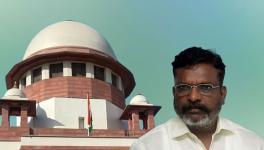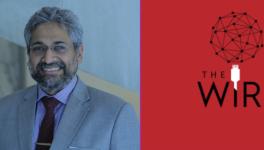Upper Castes Hold 90% of Major Positions in Indian Mainstream Media
Representational use only.Image Courtesy:Istock
Fact: The second media diversity survey after 2019, reported by Oxfam India-Newslaundry on October 14, found that less than 5% of panelists in Hindi and English TV debates come from SC or ST categories.
New Delhi: By the way, our country is passing through an era of Amritkaal, and claims are being made by the government that now the country is moving toward inclusiveness and progress. But the reality is something else. Although every section of the society in the country has been facing acute unemployment, inflation and hunger during the Amritkaal period, but the situation of the deprived sections i.e SC/ST sections is very frightening. This is evident by the fact that Oxfam India has made startling revelations in the second survey conducted on the media, after the first survey which was conducted in 2019.
This survey and report on it by Oxfam India and Newslaundry titled 'Who Tells Our Stories Matters: Representation of Marginalized Cast Groups in Indian Media' shows that almost 90% of leadership positions in print, TV and digital media are dominated by general caste goups or upper caste groups. It also noted that not a single person from the Scheduled Castes (SC) or the Scheduled Tribes (ST) communities is leading the mainstream media outlets.
The report released by South Asia's largest news media forum 'The Media Rumble' also reveals that every 3 out of 5 articles in Hindi and English newspapers are written by general caste writers, while marginalised castes ( SC, ST or OBC) are only able to contribute 1 out of 5 articles.
Oxfam India CEO Amitabh Behar said, “Our second report in a span of three years shows that the newsroom in India is not an inclusive place for the country’s underprivileged communities. The fact is that even after all these years, the proprietors/leaders of media organisations have failed to create an enabling environment for dalits, adivasis and the Bahujan Samaj. The report also pointed out that the media in the country not only in its coverage but in its recruitment policy should uphold the constitutional principle of equality. Therefore, it becomes important that media organisations bring about a significant change in the system of recruitment and ensure that newsrooms across the country become more diverse and inclusive. This will help India to be free from discrimination and injustice, and it will also play an important role in nation building."
How the Report Examines Diversity in the Media
The report studied the coverage, social leadership, and caste structure of journalists working in nearly 43 Indian print, TV and digital media outlets. The research, conducted between April 2021 and March 2022, analyzed over 20,000 magazine and newspaper articles, 2,075 prime time debates with 76 anchors and 3318 panelists, and 12 months of online news reports. The research was conducted on qualitative parameters such as the social status of the authors/participants, the prominence of the news content, and the subject matter of the news coverage. The report has also examined the representation of different caste groups among the employees of the news organization, considering the database of UPSC and Central universities as secondary sources of information.
What Does the Analysis say?
The analysis says that the overall representation of SCs, STs and OBCs in the Indian media has improved only marginally. 12 months of research shows that print, digital and electronics media are dominated by general caste groups in terms of leadership, by-line writers, opinion writing and content. This was compared with the 2019 report in which the number of journalists from the general category was more than 88℅; it is around 86% this year. The biggest change can be seen in the representation of the SC category, which has registered a growth of 3.17% in 2022.
An analysis of 14 Hindi and English newspapers revealed that media organisations have failed to hire SC/ST journalists to cover caste and tribal issues. When 8 news channels were analysed, it was found that more than half of the anchors belonged to upper caste groups, while not a single dalit or adivasi journalist was found hosting or anchoring debates in any of the channels.
In the 12 journals analysed in the survey, not a member of the SC/ST community was found in the leadership position, whereas, representation of SCs and STs has shown comparatively some improvement in digital media platforms as compared to print and electronic media. The representation of SC and ST in digital media has increased from zero to 11% for SCs and about 3%% of STs, respectively. While the OBC category has seen a slight increase, the representation of the general category is still around 77% in digital media.
Finally, the report recommended media organisations to be more sensitive on the implementation of a more transparent recruitment system, equal and fair pay in terms of caste.
An era of Increasing Inequalities
If you look at the figures of inflation, unemployment and increased hunger, then this so-called ‘Amritkaal’ will change ‘Mrityukaal’ for crores of people, who belong to marginalised communities. This is true for dalit and tribal sections for whom employment opportunities are continuously decreasing. Reservation has been neutralised due to ban on recruitment in Central and state government jobs, and private players are not ready to implement reservation for the community.
British Prime Minister Liz Truss was forced to resign because she waived the £45 billion tax liability for billionaires in her 'mini budget', that too at a time when the country was battling inflation, unemployment and rising bank loan rates. This created uproar in the country and eventually Truss had to resign. But does this matter in India? If it had, Narendra Modi would not have been the Prime Minister of the country today. In the last 8 years, the Modi government has waived off Rs 10.7 lakh crore of big capitalists/corporate houses, while in 2021 alone this waiver has been of Rs 2.02 lakh crore. The challenges before the underprivileged community of the country are innumerable and it seems impossible to achieve anything without getting organised. To strengthen the foundation of democracy, it is necessary for the society to be inclusive.
The writer is a freelancer. Views are personal.
Get the latest reports & analysis with people's perspective on Protests, movements & deep analytical videos, discussions of the current affairs in your Telegram app. Subscribe to NewsClick's Telegram channel & get Real-Time updates on stories, as they get published on our website.
























